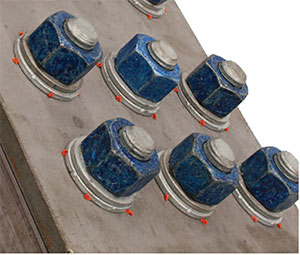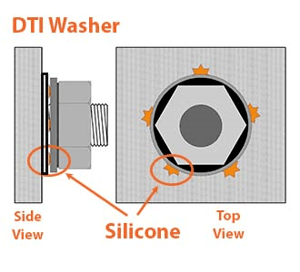 Also known as Squirter Washers, the DTI Washer provides the steel fabricator and erector the ability to positively identify a structural bolt is delivering the require compression to the connection. Some customers believe the DTI Washer must be used in one method, the most common which is DTI under nut with the nut turning. (See Below and /or Download the DTI Installation Chart.) For the washer to function it must be installed correctly, however there are four different correct configurations available to the assembler.
Also known as Squirter Washers, the DTI Washer provides the steel fabricator and erector the ability to positively identify a structural bolt is delivering the require compression to the connection. Some customers believe the DTI Washer must be used in one method, the most common which is DTI under nut with the nut turning. (See Below and /or Download the DTI Installation Chart.) For the washer to function it must be installed correctly, however there are four different correct configurations available to the assembler.
What is common throughout is the DTI Washer never contacts the rotating surface of the nut or bolt head. If that were the case the rotation would case wear on the DTI Ridges which would reduce the resistance. This would cause the washer to compress prematurely. Below are shown the 4 methods of properly installing and tightening a DTI Washer.
DTI Under Bolt Head – Nut will be turned
The order of this installation is, structural bolt head, DTI Washer with bumps touching underside of the bolt head, the steel plies. On the other side of the connection an F-436 washer, the structural heavy hex nut. In this case the connection will be tightened by turning the nut. It is important the bolt head does not rotate and weaken the DTI Washer.
DTI Under Bolt Head – Bolt Head will be turned
As above, begin with the structural bolt head. Then install an F-436 washer, then the DTI washer with the bumps touching the washer. The steel plies are next. On the other side the heavy hex nut can sit directly on the steel surface but as a rule it is usually best to employ a washer here also. The bolt head can be turned and the F-436 washer will protect the ridges in the DTI washer and also provide even distribution of pressure as the connection is tightened.
DTI Under Heavy Hex Nut Head – Nut will be turned
Start with the structural bolt head that can sit directly on the steel surface and pass through the steel plies. On the opposite side the DTI washer sits against the steel, bumps facing away. Then an F-436 washer followed by the heavy hex nut. The nut can be turned and the F-436 washer will protect the squirter washer.
DTI Under Heavy Hex Nut Head – Bolt Head will be turned
The structural bolt is inserted with an F-436 hardened washer between the bolt head and the steel member. On the other side of the steel a DTI washer sits on the steel surface, again bumps up, followed by the heavy hex nut. In this case it is important the nut does not rotate as the connection is being compressed.
It is worth repeating, the DTI Washer can sit on the structural member or be separated by a washer, but it should never be installed with the bumps facing the member and never be touching a rotating surface.
View the DTI Washer catalog page.



